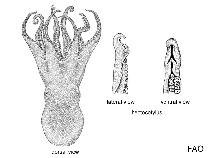Octopus pallidus Hoyle, 1885
Pale octopusWarning: DOMDocument::load(): SSL operation failed with code 1. OpenSSL Error messages: error:140770FC:SSL routines:SSL23_GET_SERVER_HELLO:unknown protocol in C:\Apache24\htdocs\includes\SpeciesSummary.lib.php on line 1236
Warning: DOMDocument::load(): Failed to enable crypto in C:\Apache24\htdocs\includes\SpeciesSummary.lib.php on line 1236
Warning: DOMDocument::load(https://sealifebase.nrm.se/webservice/AquaMaps/getAMap.php?genus=Octopus&species=pallidus): failed to open stream: operation failed in C:\Apache24\htdocs\includes\SpeciesSummary.lib.php on line 1236
Warning: DOMDocument::load(): I/O warning : failed to load external entity "https://sealifebase.nrm.se/webservice/AquaMaps/getAMap.php?genus=Octopus&species=pallidus" in C:\Apache24\htdocs\includes\SpeciesSummary.lib.php on line 1236
Classification / Names Common names | Synonyms | CoL | ITIS | WoRMS
| Octopoda | Octopodidae | Octopodinae
Environment: milieu / climate zone / depth range / distribution range Ekologi
; kisaran kedalaman 3 - 589 m (Ref. 100702). Subtropical
Penyebaran Negara-negara | Daerah-daerah FAO | Ecosystems | Kemunculan | Introduksi
Southwest Pacific.
Length at first maturity / Size / Weight / umur
Maturity: Lm ? range ? - ? cm Max length : 54.0 cm TL jantan/; (Ref. 96968)
Mantle length is 13 cm (Ref. 122358). Immediately begins to feed upon hatching. Forages at night and hides in rubble or human refuse (e.g. discarded bottles). Primarily feeds on bivalves either by drilling or pulling them apart. Armed with good skin sculpture and camouflage (Ref. 100823).
Life cycle and mating behavior Kematangan | Reproduksi, perkembang biakan | Pemijahan | telur-telur | Fecundity | Larva
Members of the class Cephalopoda are gonochoric. Male and female adults usually die shortly after spawning and brooding, respectively. Mating behavior: Males perform various displays to attract potential females for copulation. During copulation, male grasp the female and inserts the hectocotylus into the female's mantle cavity where fertilization usually occurs. Life cycle: Embryos hatch into planktonic stage and live for some time before they grow larger and take up a benthic existence as adults.
rujukan utama
Acuan | Koordinator | mitra
Bisby, F.A., M.A. Ruggiero, K.L. Wilson, M. Cachuela-Palacio, S.W. Kimani, Y.R. Roskov, A. Soulier-Perkins and J. van Hertum. 2005. (Ref. 19)
Status IUCN Red List (Ref. 130435)
kurang bimbang (LC) ; Date assessed: 15 July 2015
status CITES (Ref. 108899)
Not Evaluated
CMS (Ref. 116361)
Not Evaluated
ancaman kepada manusia
penggunaan manusia
| FishSource |
Alat, peralatan
informasi lanjut
Nama-nama umum
Sinonim (persamaan)
Pemangsa
Reproduksi, perkembang biakan
Kematangan
Pemijahan
Fecundity
telur-telur
pekembangan telor
Sinonim (persamaan)
Pemangsa
Reproduksi, perkembang biakan
Kematangan
Pemijahan
Fecundity
telur-telur
pekembangan telor
Sumber internet
BHL | BOLD Systems | CISTI | DiscoverLife | FAO(Publication : search) | Fishipedia | GenBank (genom, Nukleotida) | GloBI | Gomexsi | Google Books | Google Scholar | Google | PubMed | Tree of Life | Wikipedia (pergi, Cari) | Zoological Record
Estimates based on models
Preferred temperature
(Ref. 115969): 13.3 - 20.2, mean 15.3 (based on 25 cells).



